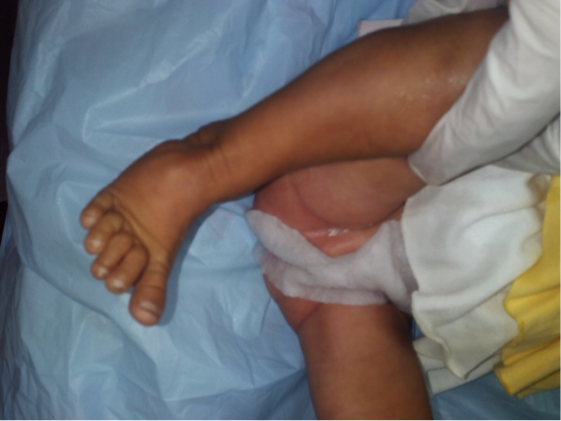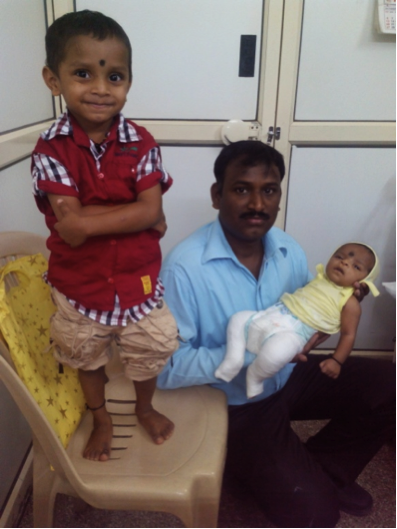The newborn feet are two of the most complex structures in the body with a multitude of bones, ligaments, muscles and tendons making up a very flexible unit.

Being so complex, there is a huge likelihood of problems being present in the structure and function of the neonatal foot. In fact, foot problems in infants are the commonest structural abnormality seen in newborns. They range in severity from very benign, which require only supervised neglect, to very severe, which require complex reconstructive surgeries for normal walking. Here are a few of the common foot problems seen in the newborn:
1) Metatarsus adductus (Turned-in feet):
Turned-in feet or Metatarsus adductus are the commonest congenital foot problems with an estimated incidence of around 2 per 1000 live births. It basically means that the inner portion of the foot and the great toe is turned towards the midline. It is a relatively benign condition, with most kids being treated just by simple manipulation and stretching exercises which are to be done by the mother. These exercises are taught to the mother during the first visit and she is asked to do these simple exercises every time she breastfeeds the child. This is usually enough to completely correct the foot. In some rare cases which do not correct well with maternal manipulations, two or more serial plaster casts may be required to obtain full correction.

Clinical picture of a newborn’s foot with mild metatarsus adductus
2) Clubfoot:
Clubfoot, also known as CTEV, is the commonest congenital foot condition requiring orthopaedic attention. Clubfoot and especially neglected clubfoot has become such a large public healthcare problem that the Government of India has included clubfoot in one of the 8 notifiable diseases of the newborn.
Clubfoot is a condition where the foot is turned and twisted inwards, so that the lower plantar surface of the foot is almost facing the leg. The heel cord is tight, making it impossible to correct the foot just by passive manipulation. As the foot and ankle is in a severely twisted position, the foot and ankle cannot move normally while walking. Usually clubfoot is an isolated deformity, though in a small percentage of patients, it is associated with contractures of other joints like hip and knee as well as certain spinal anomalies like spina bifida.
Till a few years back, the only treatment used to be surgical correction of the deformity, which used to make the foot stiff, short and painful. However, in the past decade or two, the “Ponseti” method of serial casting has revolutionized the treatment of congenital clubfoot. This method was described by Professor Ignacio Ponseti from university of Iowa in the mid-60’s but gained popularity in the later part of the twentieth century. In this method of treatment, the deformity is serially corrected using weekly casts followed by a small cut of the heel-cord which can be performed under local anaesthesia. The entire treatment takes around 2-4 months after which a normal-looking, supple and painless foot can be obtained. After good correction is obtained, it is to be maintained using special shoes for a period of 3-5 years. This is perhaps the only method of treatment of clubfoot which has consistently good results even in the long term, especially when treatment has been initiated very early in life.
Thus , to summarize, Clubfoot is a relatively common childhood condition that requires vigorous orthopedic treatment. With expert early treatment, a clubfoot patient will wear regular shoes, take part in sports, and lead a full, active life. Parents who have a child with clubfoot should find an orthopedic surgeon who is an expert in its treatment and work closely with them to provide the best possible result for their child.

Clinical photograph of a newborn child with congenital clubfoot (a) showing complete correction of the feet after 3 serial plasters and a small suture-less tendon release.

Story of the two brothers: These two siblings had clubfoot. Viraj, the elder one was treated by me for congenital clubfoot with serial casts 3 years back. Now he has absolutely normal-looking feet which are very flexible and is wearing normal shoes. He is one of the most playful boys in his class and regularly comes first in running races. He has brought his brother, Pratik, who also unfortunately has congenital clubfoot, for serial plasters. Pratik also is well on his way towards full correction.
3) Congenital calcaneo-valgus foot:
Congenital calcaneo-valgus foot deformity is another common foot condition, in which the foot is turned upwards so that the front of the foot (dorsum) is touching the shin of the leg. Though the appearance of the foot looks a bit scary, it is a very benign condition. It is like a “packaging” defect, since it develops because there is very little space in the uterus especially in first borns and twins. The best treatment for this is again manipulation by the mother. Usually this corrects the deformity, even though in some cases, prolonged bracing may be required.
4) Congenital vertical talus:
Congenital vertical talus, also known as rockerbottom foot, is one of the serious orthopaedic conditions affecting the newborn foot. This condition is associated with a “break” in the middle of the foot so that the foot looks like the bottom of a rocking chair –hence the name. Congenital vertical talus is associated with other joint abnormalities in almost 50% of cases (unlike clubfoot). Also, unlike clubfoot, the prognosis of this disorder is not all that good, and it requires a prolonged management. Management entails serial plasters for a few weeks to months and then most of them require major surgery even after that.

Clinical picture of a newborn with congenital vertical talus(rockerbottom foot) which looks like the bottom of a rocking chair- hence the name.
5) Syndactyly and polydactyly:
These numerical abnormalities of the feet are the most obvious disorders and are associated with many myths and superstitions. The problems associated with extra toes (polydactyly), joined toes (syndactyly) and joined extra toes (poly-syndactyly) are not just cosmetic but also functional since there is difficulty in shoe wear and increased propensity of wounds to the extra and fused toes. The treatment of these extra-fused toes is surgical excision of the extra toe as well as reconstruction of the remaining toes if abnormal.

The story of Raj, the 26 fingered-and-toed boy: Raj had 7 toes in every feet and 6 fingers in every hand since birth .The parents wanted the extra toes of his feet removed due to recurrent wounds and difficulty in shoe wear. Clinical picture of the same child after surgical excision and reconstruction has been shown. The parents did not want surgery for his hands since “they were like Hrithik Roshan’s!!”
Dr. Mandar Agashe is a Paediatric Orthopaedic surgeon practicing in Mumbai. He received his medical degree from the prestigious King Edward memorial hospital, Mumbai, in the process of which he received two Gold medals as well as secured distinction in as many as 10 of the 14 subjects. He is one of only three surgeons from India, to have received advanced training in Paediatric and Adolescent hip disorders at the International hip centre at Rady Children’s hospital, San Diego. He is also the recipient of the prestigious “Professor Kaye Wilkins fellowship” under the auspices of Paediatric Orthopedic society of India.


Dr Mandar, excellent laudable effort of putting complex medical knowledge in user friendly language
I see a lot of interesting articles on your blog. You have to
spend a lot of time writing, i know how to save you a lot of work, there
is a tool that creates readable, google friendly posts in couple of seconds, just search in google – k2 unlimited content
Dr. Mandar has clarified by doubt about club foot and I am happy he would be treating my grandson.
Thanks, Philomena
The sole aim of our effort is to empower consumers.